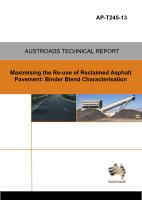Pavement

- Publication no: AP-T245-13
- ISBN: 978-1-925037-18-0
- Published: 28 August 2013
- PDF (free) Download
This report presents the findings from the first year of a three year Austroads study which aims to maximise the re-use of reclaimed asphalt pavement (RAP) in new asphalt product. The objective of this first year of study is to improve the methodology for the characterisation of RAP binders and the design of the binder blend in asphalt mixes containing RAP.
The study included a literature survey of the current international state of practice in terms of RAP binder characterisation. It further included experiments to develop a more practical and cost-effective approach to characterising the properties of binder blends containing RAP. The experimental work showed that the Dynamic Shear Rheometer (DSR) can be used to obtain viscosity parameters similar to the Shell sliding plate viscosity at 45 °C and the capillary viscosity at 60 °C. The DSR results are also more repeatable than the results of the Shell sliding plate test, which has conventionally been a more common test used in Australia for the characterisation of RAP binder.
The results show that for the RAP sources under study, a blend of C170 with 10% to 20% RAP does result in a viscosity equivalent to that of a C320, as generally accepted in current practice.
The DSR based methodology used in this study provides a practical, consistent and cost-effective method to characterise RAP binder blends. As successfully demonstrated in this study, the viscosity results from the DSR tests can be used to design RAP binder blends to a desired viscosity. The methodology will be further validated during the next year of this study, when it will be used to design binder blends for asphalt mixes containing various percentages of RAP.
- 1. Introduction
- 1.1. Arguments for the Re-use of RAP
- 1.2. Performance of High RAP Content Mixes
- 1.3. Usage of Available RAP Stockpiles
- 1.4. Problem Statement
- 1.5. Objectives
- 1.6. Structure of the Report
- 2. State of Parctice in RAP Binder Characterisation
- 2.1. Interaction between RAP Binder and Virgin Binder
- 2.2. Properties of the RAP/Virgin Binder Blend
- 2.2.1. State of Practice in Australia
- 2.2.2. Australian and New Zealand Road Agency Specifications with Regard to the use of RAP
- 2.2.3. RAP Binder Classification in the USA Prior to Superpave
- 2.2.4. Superpave Binder Classification for RAP
- 2.2.5. European RAP Mix Binder Classification
- 2.3. Discussion on State of Practice
- 3. Experimental Work
- 3.1. Year 1: Characterising the Binder Blend
- 3.2. Year 2: RAP Mix Performance
- 3.3. Year 3: High Performance High RAP Content Mix Design
- 3.4. Laboratory Procedures
- 3.4.1. Capillary Viscosity
- 3.4.2. Binder Extraction
- 3.4.3. Production of the RAP Binder Blend
- 3.4.4. DSR Creep Test
- 3.4.5. DSR Frequency Sweep
- 4. Results
- 4.1. ‘Conventional’ Viscosity Tests
- 4.2. Complex Viscosity Master Curves
- 4.3. Comparison between DSR and Shell Sliding Plate Results
- 4.4. Viscosity at 60 C
- 4.5. Discussion of Results
- 5. Blend Viscosity Prediction
- 5.1. Comparing Viscosity Prediction Rules
- 5.2. Designing Blends to a Desired Viscosity
- 6. Conclusions and Proposed Blend Specification Guideline
- 6.1. Conclusions
- 6.2. Guideline for RAP Binder Blend Design and Specification
- References
